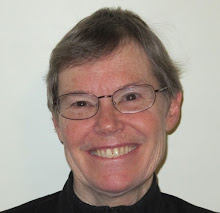The cargo carried on this board was sometimes me, and later, my sister. In the next image you can see how I (in snowsuit) was strapped securely to the packboard.
 |
| Click on the image to enlarge it. Note that I am smiling. |
These photos do not reveal the shoulder straps which must be holding the pack-board to my parent's shoulders. My mother, left, and my father, right, were standing in our front yard (120 Nichols Street, Danvers) when these photos were taken. The next photo (same location) shows the pack-board and baby inside a knapsack carried by my father. Note that he was on skis. My sister and I were introduced to skiing at a very early age.
The next photo shows our whole family ready for a winter outing. My sister Jean was in the knapsack, and I was in a basket on the sled.

Last week while cross-country skiing in the Adirondacks, I observed young families carrying babies in a variety of special child-carriers, some carried on the back, some dragged on the snow. I didn't see any home-made pack-boards in use, but there was a sturdy wooden pack frame on display in the ski lodge:
 |
| The pack-board in this display, seen February 2015 at Mt Van Hoevenberg, Lake Placid, NY, is oriented upside down, I think. Note the position of the shoulder straps. |
----------
Below is a piece I wrote about my memories of this pack-board. I submitted it to the Danvers Herald for the Remembering Danvers column in March 2015.
Remembering Danvers
12-8-14; revised 3-1-15
Strapping a baby to a pack-board
By Sandy Nichols Ward
A pack-board is a handy thing. My parents used one to carry me when I was a baby. They strapped me onto the board, added shoulders straps, and carried me like a papoose. Sometimes they slide the board inside a canvas bag, or knapsack, with its own shoulder straps attached. Either way, I was securely and safely strapped to the board, and my parent could carry me conveniently, with their hands free for other tasks. My hands were free to wave around; the straps only constrained my chest and upper legs.
Typically, I was dressed in a puffy snowsuit that provided padding between my body and those straps. I have no memory of being carried that way, but I do have several photographs showing my parents carrying me, a July baby, on that pack-board during the fall, winter, and spring of my first year.
I also have my mother’s stories. She loved to tell about the time they propped up that board, with me on it, against a tree near the top of the Locust Lawn ski hill, letting me watch the skiers while they themselves could ski freely, and check on me each time they came around. The ski hill was short, and the rope tow brought them up again quite quickly, so I wasn’t unattended for long. My parents report that I smiled and seemed very happy there, so they continued skiing. When at last my mother took me home and undressed me, she was appalled to discover that my feet had turned blue with cold. In spite of that, I hadn’t cried or fussed at all. I had been well entertained by the passing skiers on that family-friendly ski hill so close to our home.
I enjoy seeing the old photos and reflecting on my very early introduction to skiing, which was to become an important part of my childhood and teenage years. The photos also make me think of the thriftiness of my parents, who were simply adapting an existing knapsack – no doubt used many times previously on outing club hikes – to carry their first born. Whether the pack-board was new, or had been used for other loads, I do not know. Nor can I see in the photos any details of how the straps were tied to the board.
But I do have, in addition to the photos, the board itself! New England families rarely throw things away, especially not a practical item like a pack-board that could be useful in the future. I remember playing with that board which I knew had been used to carry me. The holes and slots in it are roughly-hewn; it is clearly homemade. How very simple compared to the elaborate child carriers of today. It is closer to the cradleboards used by Native Americans, though it lacks the curved top and the bottom board typical of those carriers. Ours is just a plain pine board, ½ inch thick, about a foot wide and 33” tall. Nothing special, except the memories that go with it.


